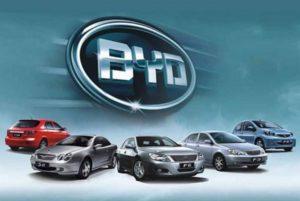 China-based plug-in electrified vehicle manufacturer BYD has become the third largest seller of PEVs in the world. The company is following Renault-Nissan and right behind Tesla Motors in cumulative annual global sales through September; at 161,000 sold versus Tesla’s 164,000, BYD could become No. 2.
China-based plug-in electrified vehicle manufacturer BYD has become the third largest seller of PEVs in the world. The company is following Renault-Nissan and right behind Tesla Motors in cumulative annual global sales through September; at 161,000 sold versus Tesla’s 164,000, BYD could become No. 2.
BYD has now surpassed Mitsubishi as the third largest global seller of PEVs. Mitsubishi has seen most of that sales volume come through its Outlander plug-in hybrid doing well in Europe. During the summer, Mitsubishi announced that the long-delayed launch of the SUV in the U.S. market will be delayed yet again, the fifth time that delay happened since its 2013 Japan-market launch.
BYD is seeing a limited but growing presence in the U.S. through its electric buses and sanitation trucks. But what about selling electric cars in hotspots like California and other U.S. markets with a lot of interest in PEVs?
There have been rumors and analytical speculation about BYD, with its 10% ownership stake from Warren Buffet and Berkshire Hathaway, bringing some of its top-selling electric car models to the U.S. The company dominating the fast-growing Chinese PEV market should be able to grab hold of solid footing in America, right? Even with climate-change doubter Donald Trump taking over the White House, other automakers are counting on U.S. electric car sales to grow quite a bit.
So far, China is winning out. BYD’s top-selling model, the BYD e6 all-electric car, was flat in sales not long ago with 33 units sold in China in 2010. BYD sold 3,118 e6 units in China last month. The company held five of the top 12 spots for PEVs sold in China during October. Competition has been with other Chinese brands, with the Tesla Model S coming at No. 12 that month. Tesla and other automakers with partnerships in China, including General Motors, are rolling out Chinese market versions of cars like the Chevy Bolt to compete in that fast-growing market.
Why China?
Chinese government incentives for new energy vehicles (NEVs).have made that growing market more attractive than the U.S. for BYD. Government subsidies in China can be as high as 90,000 yuan ($13,000) and more consumers are buying in. Chinese automakers are taking the market even more seriously with a wide range of passenger cars, crossovers, and SUV selling to Chinese consumers. Local Chinese automakers make up most of the electric car market and are now seriously investing in research and development, developing better cars with more power and longer range, which is helping sales. This year’s Guangzhou Auto Show, held this month in China, saw the debut of over 30 new energy vehicles.
Starting in 2013, plug-in hybrids such as the BYD Qin and Tang, were top sellers for the company. More recently, all-electric models have taken the lead, with the e6 and newcomer models e5 and Qin EV300 doing very well. Increasing battery capacity and range for all-electric models has helped sales increase. BYD has also done well selling to both consumers and fleets in the Chinese market, as both customer segments show more interest in plug-in models overall and more confidence in all-electric models and China’s charging infrastructure.
BYD America
Incentives have been stronger in China for BYD. Earlier this year, BYD America Vice President Michael Austin said that the $7,500 tax credit provided by the U.S. federal government is insufficient if there isn’t support from the federal and local governments in the form of more charging infrastructure. Austin said that about 80 BYD e6 electric cars have been imported to the US, with about 50 of those brought to New York for taxi and ride-hailing purposes.
“Right now, we really don’t have parts and distribution or consumer warranty service, and we don’t have a dealer network,” said Austin to Autoblog. “It’s easier to service fleets.”
BYD America has been visible at events in the U.S. such as ACT Expo with its electric bus models, which lead the North American market in electric bus sales. Other commercial vehicles are coming up. BYD America operates a manufacturing assembly plant in Lancaster, Calif.
This month, BYD America launched the industry’s first all-electric, long-range electric garbage truck. The refuse truck was a project jointly developed with Wayne Engineering, an Iowa-based refuse truck equipment maker.
There has been concern that Trump, with his doubts about climate change and the EPA, and support for fossil fuels, could alter national environmental and fuel-efficiency policies. Is the electric garbage truck a dying cause? Probably not, according to industry insiders.
“No one has a crystal ball, but there are some business case and regional and global market trends that make us believe that electric truck development and targeted deployment will continue,” Bill Van Amburg, senior vice president and trucking programs director at Calstart, told Trucks.com.
The trend toward greater electrification is meeting customer demands for efficiency and operational improvements and is not tied to U.S. energy policy, wherever that may end up going, he said.
That perspective, for now, seems to be shared by automotive executives interviewed about the post-Trump election impact on U.S. auto sales. Ambitious goals of launching several new PEV models in the U.S., Europe, and other markets, still seem to be in place for Volkswagen, Daimler, BMW, GM, Tesla, and a few others.
While selling more electric cars in the U.S. appears to be on hold now for BYD, expanding beyond China is not off the company’s strategic planning. Korea is one of those markets
Last week, BYD completed registration of its office in Korea and secured a dealership to sell its cars. Tesla is also set to open a store soon, in the city of Hanam.



